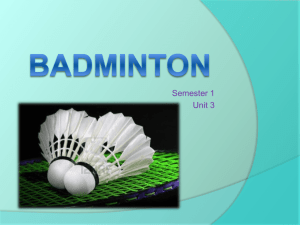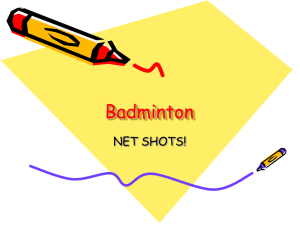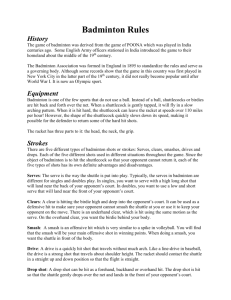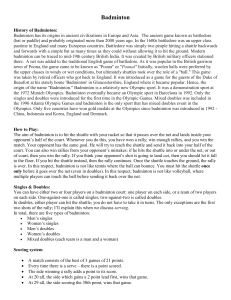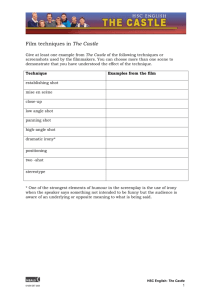10 RULES Of BADMINTON Badminton is a racket sport that needs
advertisement
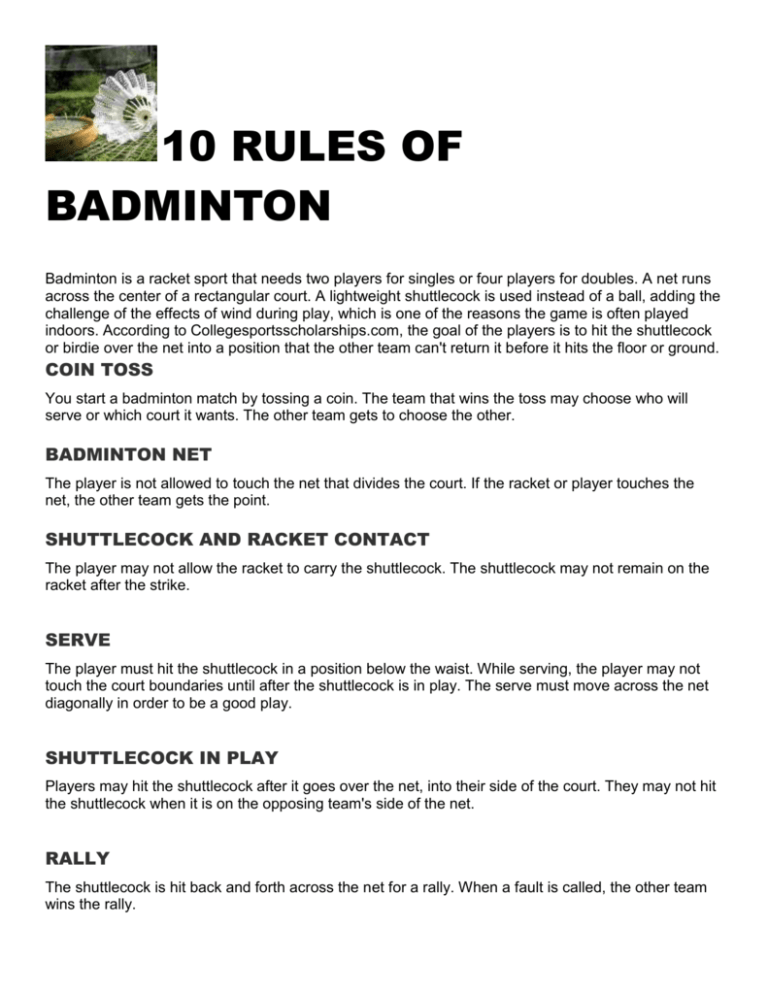
10 RULES OF BADMINTON Badminton is a racket sport that needs two players for singles or four players for doubles. A net runs across the center of a rectangular court. A lightweight shuttlecock is used instead of a ball, adding the challenge of the effects of wind during play, which is one of the reasons the game is often played indoors. According to Collegesportsscholarships.com, the goal of the players is to hit the shuttlecock or birdie over the net into a position that the other team can't return it before it hits the floor or ground. COIN TOSS You start a badminton match by tossing a coin. The team that wins the toss may choose who will serve or which court it wants. The other team gets to choose the other. BADMINTON NET The player is not allowed to touch the net that divides the court. If the racket or player touches the net, the other team gets the point. SHUTTLECOCK AND RACKET CONTACT The player may not allow the racket to carry the shuttlecock. The shuttlecock may not remain on the racket after the strike. SERVE The player must hit the shuttlecock in a position below the waist. While serving, the player may not touch the court boundaries until after the shuttlecock is in play. The serve must move across the net diagonally in order to be a good play. SHUTTLECOCK IN PLAY Players may hit the shuttlecock after it goes over the net, into their side of the court. They may not hit the shuttlecock when it is on the opposing team's side of the net. RALLY The shuttlecock is hit back and forth across the net for a rally. When a fault is called, the other team wins the rally. SCORING When the team wins a rally, a point is scored. According to Badminton.org, men may play to 15 or 17 total points for a game, and women may play to 11 or 13 total points. Points are scored by the serving team. FAULT A fault is called when a player doesn't hit the shuttlecock over the net or hits it out of bounds. Other faults in badminton include striking the shuttlecock above the waist, touching the net with any part of the body or racket, allowing the shuttlecock to rest of the racket, hitting the shuttlecock into the ceiling and hitting the shuttlecock into or under the net. STRIKES Players may not hit the shuttlecock twice in a row. Players may only hit the shuttlecock once per inning. After the shot, the shuttlecock must go over the net and be returned by the other team for that player to hit the shuttlecock again. BADMINTON ETIQUETTE Badminton etiquette is essential for the sport to be fun and fair. Players should call their own illegal shots and return the shuttlecock in a gentle manner for the next serve, according to Official Badminton. Each server should state the score before serving. After the match is over, the opponents should shake hands. BADMINTON SERVE RULES Badminton became an Olympic sport in 1992. Rules for badminton, including service of the shuttlecock, are set by the Badminton World Federation, formerly known as the International Badminton Federation. The IBF altered its rules in the mid-2000s to pick up the pace of the game and make it more attractive for TV audiences, reports BBC Sport. Formerly, points were only scored on a serve. Now either team can win a point on a rally. Several other rules apply to the service in badminton. PLACEMENT Server and receiver stand in service courts that are diagonally opposite. The server's feet need to stay in contact with the ground until the serve is delivered. The shuttle needs to pass over the net and land on or within the boundary lines of the receiver's court, according to BWF rules. Sponsored Links DELIVERY The shuttle has to be hit below the server's waist, defined as the lowest part of her rib. The server has to continue movement of her racket from the start of service until the serve is delivered. The server cannot start and stop a forward movement. A server cannot deliver the shuttle before the receiver is ready. If a receiver tries to return the shuttle, rules deem that he was ready and the serve stands, according to BWF rules. SINGLES In singles play, a player serves from the right service courts when the score is even, including zero. The player serves from the left service court when he has an odd number of points scored. If the serve is returned and a rally begins, the server gains a point if he takes the rally. He serves again from the alternate service court. If the receiver wins the rally he gains a point and becomes the new server, according to BWF rules. DOUBLES In doubles play, players also serve from the right service court for an even score and the left service court for an odd score. If the server wins the point, she switches sides with her partner and continues to serve, according to BBC Sport. Alternating continues until the serve is lost to the other team. When the team becomes the receiving side, the player remains in the service court she served from, according to BWF rules. Introduction to Badminton Shots If you want to consider yourself a “complete” badminton player, there are five basic shots you must know and master. The serve, clear, drop, drive, and smash are all essential components to becoming a great player. In this guide, you’ll learn the purpose of each shot and how they fit into the game The Serve: This is the first shot you should learn, because it is easily the most important one. The quality of your serve will largely determine how the rest of the rally plays out. If you hit a poor serve, your opponent can end the rally immediately with a strong smash or well-placed drop. First and foremost, your goal is to create an opportunity for yourself, or your team, to end the rally. If your serve does not accomplish that, it should at least deny your opponent an opportunity to end the rally. Following these principles should force you to either aim the serve low and short or high and deep. Hitting to either of these extremes will make it difficult for your opponent to hit a quality shot in return. To recap, here are some of the main characteristics: The serve is the most important shot in the game. The serve can dictate how a rally will play out, favorably or unfavorably. A serve should be aimed low and short or high and deep. Backhand serve The Clear: After the serve, the clear is the second most fundamental shot in badminton. Regardless of your playing style or preferred event, the clear shot will be an integral part of your game. It’s easy to undervalue a clear shot, because it isn’t flashy and doesn’t often lead to a point. To grasp its worth, you need to understand what a clear shot aims to accomplish. On an elementary level, the variations of a clear shot can accomplish one of two things: A deep, high-arching clear can buy you time to recover for the next shot. A deep, flat clear can put your opponent in a difficult position to return the shot. In a sense, a clear can either be a defensive or offensive tactic. When you’re struggling to get in position to return a shot, a clear can be a great way to regain your balance and prepare for the next shot. Conversely, you can also use it when you’re in great position to put your opponent off-balance and make them work harder. It’s a more subtle offensive strategy, but stamina plays a bigger and bigger role as the game progresses. The Drop At its most basic level, a drop shot is any shot that lands between the net and the short service line. A drop can be taken from the baseline or at the net. In both instances, the drop is pushing the shuttlecock down and directly forcing your opponent to hit it up. Unfortunately, it does require more skill than simply placing the shuttlecock there. The landing spot is equally important as the shuttlecock’s trajectory. One without the other would immediately make it a poor drop shot. The speed of your shot will come naturally as you learn to aim the shuttlecock. Here are some tips for hitting the drop shot: Aim the drop to land between the net and the short service line. Have the shuttlecock come off the racket flat to begin its descent. Deny your opponent an opportunity to score and simultaneously create one for yourself by having a well-placed drop. Power does not automatically improve the quality of a drop shot. As such, any player with the desire and time commitment should be able to have a devastating drop. The Drive: A drive is a quick, flat shot that usually has the racket in front of you at around shoulder-height. It is an attacking shot intended to put pressure on the opponents by forcing them to react quickly and make a poor return. The great thing about drives is the range of angles you can cover just by using the panhandle grip. By using just the panhandle grip you enable yourself to cover both the forehand and backhand side easily. It will require some practice, but not having to change grips will save you valuable time in reacting to return a shot. Some defining qualities of a drive are: It’s a fast, flat shot that should pass low over the net. It relies on the wrist for power. It’s purely an offensive shot designed to pressure your opponents. Strike the shuttle when it's about a foot or two in front of your body. Snap your wrist as the racquet strikes the shuttle. Hit with a vertical racquet face to drive the shuttle forward on a flat trajectory, just over the top of the net. The Smash: Just like big serves in tennis or spikes in volleyball, smashes are the crowd-pleasers in badminton. A smash is an overhand stroke that draws power from your body rotation, shoulders, and wrist to create an explosive shot that gets to the floor in a hurry. Although the smash is fairly easy to learn, it’s definitely one of the harder shots to master. In order to be effective, a smash must be hit with both power and precision. A smash that is well-placed but slow will give the opponent enough time to reach the shuttlecock. To the same effect, a powerful smash that heads straight for the opponent’s racket doesn’t require any time to reach the shuttlecock. At its very core, a smash just wants to go home, and that home is the floor on your opponent’s side of the court. Here are a few tips to help achieve that goal: Position yourself a bit behind the shuttlecock as it falls so you can move into the shot and use your momentum to generate power. Contact the shuttlecock at the highest point you possibly can. Aim the smash away from your opponent. Keep it as close to the top of the net as possible. The court is rectangular in shape and divided into two halves by the net. The two halves are further divided into forecourt and backcourt areas. The courts are always marked for both singles and double's games and the net poles are planted outside the double's lines. The rally is initiated by the serve. A serve is always hit in the upward direction and its attacking potential is limited by various restrictions and service laws. A serve can be of different types - high serve, low serve, drive serve(hit flat towards the back area of the opponent's court) and flick serve(hit upwards, but low trajectory). There are many different types of basic badminton shots, which are played from different areas of the badminton court. From the forecourt area, the various shots that can be played are 1. Net Shot: dropping the shuttlecock into the opponent's forecourt, as close to the net as possible. 2. Net Lift: playing upwards towards the back of the opponent's court. 3. Net Kill: the shuttlecock is aimed steeply towards the floor of the opponent's court, close to the net. Badminton shots from the mid court area include the following 1. Smash: when the shuttlecock comes to you at a high level in the midcourt area, hitting it aggressively towards the opponent's floor, to finish the rally. 2. Drive: when the shuttlecock is at the net height, at the side of your body, hitting it with sufficient pace to the opponent's midcourt or backcourt area. 3. Push: hitting the shuttlecock softly into the opponent's forecourt or front midcourt area. This shot too is played in the same situation as a drive. 4. Lift: playing upwards towards the back of the opponent's court, in response to a smash or a push shot. Most badminton shots in the back court area are played overhead. Some shots in this area are 1. Clear: hitting the shuttlecock high to the opponent's backcourt. Clear shots are of two types - defensive clear and attacking clear. 2. Smash: hitting the shuttlecock steeply towards the opponent's midcourt, at high speed. 3. Dropshot: hitting the shuttlecock downwards towards the opponent's forecourt. Besides these there are various advanced strokes which are more or less, slight variations on the aforementioned basic strokes. The purpose of an advanced stroke is to introduce an element of spin into the shot catching your opponent unawares. Slicing, hitting the shuttlecock with an angled racquet is a technique commonly used for advanced strokes. Slice shots veil the direction in which the shuttle is going to hit and to make the disguise powerful shots by making them travel slowly. Double motion is another useful technique to deceive your opponent. It involves making an initial movement towards the shuttlecock and then changing the face of the racquet and hitting it in a different direction. Badminton Glossary Descriptions of many terms and expressions used in the sport of badminton. Alley - extension of the court by 1-1/2 feet on both sides for doubles play Back Alley- Area between the back boundary line and the long service line for doubles. Backcourt- Back third of the court, in the area of the back boundary lines. Balk (Feint)- Any deceptive movement that disconcerts an opponent before or during the service. Baseline- Back boundary line at each end of the court, parallel to the net. Carry- An illegal tactic, also called a sling or a throw, in which the shuttle is caught and held on the racquet and then slung during the execution of a stroke. Center or Base Position- Location in the center of the court to which a singles player tries to return after each shot. Center Line- Line perpendicular to the net that separates the left and right service courts. Clear- A shot hit deep to the opponents back boundary line. The high clear is a defensive shot, while the flatter attacking clear is used offensively. Court- Area of play, as defined by the outer boundary lines. Drive- A fast and low shot that makes a horizontal flight over the net. Drop- A shot hit softly and with finesse to fall rapidly and close to the net on the opponent's side. Fault- A violation of the playing rules, either in serving, receiving, or during play. Feint (Balk)- Any deceptive movement that disconcerts an opponent before or during the service. Flick- A quick wrist and forearm rotation that surprises an opponent by changing an apparently soft shot into a faster passing one; used primarily on the serve and at the net. Forecourt- Front third of the court, between the net and the short service line. Hairpin Net Shot- Shot made from below and very close to the net with the shuttle rising, just clearing the net, and then dropping sharply down the other side. The shuttle's flight approximates the shape of a hairpin. Halfcourt Shot- A shot hit low and to midcourt, used effectively in doubles against the up-and-back formation. Kill- fast downward shot that cannot be returned; a "putaway". Let- A legitimate cessation of play to allow a rally to be replayed. Long Service Line- In singles, the back boundary line. In doubles a line 2-1/2 feet inside the back boundary line. The serve may not go past this line. Midcourt- The middle third of the court, halfway between the net and the back boundary line. Net Shot- Shot hit from the forecourt that just clears the net and then falls rapidly. Push Shot- Gentle shot played by pushing the shuttle with little wrist motion, usually from the net or midcourt to the opponent's midcourt. Rally- Exchange of shots while the shuttle is in play. Serve (Service)- Stroke used to put the shuttlecock into play at the start of a rally. Service Court- Area into which the serve must be delivered. Different for singles and doubles play. Short Service Line- The line 6-1/2 feet from the net which a serve must reach to be legal. Shuttlecock (Shuttle)- Official name for the object that the players must hit. Composed of 16 goose feathers attached to a cork base covered with leather. Synthetic shuttles are also used by some. Smash- Hard-hit overhead shot that forces the shuttle sharply downward. Badminton's primary attacking stroke. Wood Shot- Shot that results when the base of the shuttle is hit by the frame of the racket. Once illegal, this shot was ruled acceptable by the International Badminton Federation in 1963.
